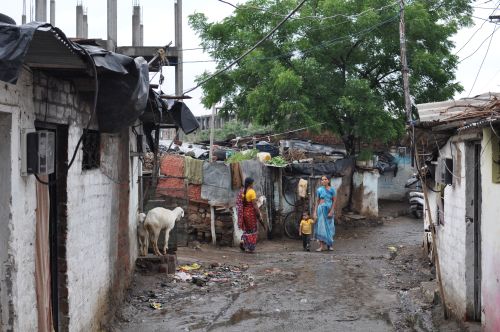India’s demographic shift to cities has been accompanied by a number of pressing governance and developmental challenges, among the most serious of which is the rampant spread of slum settlements. Within these poor urban neighbourhoods, certain residents rise to prominent positions of local authority. Based on resident and leader surveys conducted during 2015-2016 in Jaipur and Bhopal, this two-part column provides insights on these informal slum leaders.
The first part focusses on the range of activities slum leaders perform for residents, and the ways in which leaders emerge from within their communities.
Slum settlements are spaces defined by their haphazard construction, material poverty, tenure insecurity, and lack of basic public services. The 2011 Census of India estimates that 65 million people reside in the country’s urban slums. This is a staggering figure, exceeding the entire population of countries like Argentina, Spain, and South Africa.
Within these poor urban neighbourhoods, certain residents rise to prominent positions of local authority. These slum leaders spearhead efforts to resist eviction and demand public services for their settlements. Their position is informal and without State sanction. It rests on local public support. Yet despite their pervasive presence, and the important role they play in shaping local patterns of development and electoral politics, we know surprisingly little about India’s slum leaders. How do they emerge within their settlements? What activities do they engage in? And which of the many resident demands they receive do they prioritise?
In this two-part column, we outline some preliminary answers to these questions based on original surveys we have conducted over the past several years in two important Indian cities: Jaipur, Rajasthan and Bhopal, Madhya Pradesh. In this column, we draw on a survey of 2,199 residents across 110 slums we conducted in the summer of 2015. These responses helped us learn the range of activities slum leaders perform for residents, and the ways in which leaders emerge from within their communities.
In the next part of this column, we draw on our second survey, conducted in the summer of 2016, of a sample of 629 slum leaders across those same 110 settlements. We draw on this leader survey to discuss who slum leaders are — their age, professions, and relationships with political parties — and how they build support within their communities. To our knowledge, this is the first large and representative survey of informal slum leaders ever conducted.
What do slum leaders do?
Our fieldwork and survey data reveal that slum leaders perform a wide range of activities. They help mediate resident access to essential State services — ration cards, voter ID cards, electricity connections, widow pensions, bank accounts, and caste certificates. They also resolve disputes among neighbours. For their settlements, slum leaders organise efforts to fight eviction and demand public services — paved roads, streetlights, schools, drainage, sewers, and trash collection.
Slum leaders often refer to these many activities as samajik seva, or social work, but this label should not suggest they lack explicit political motivations. Indeed, slum leaders are well positioned to influence local voting behaviour through everyday conversations and the targeted distribution of material benefits - petty cash, food, and liquor. They are also positioned to galvanise their followers for rallies and bring them to the polls during elections. Our surveyed slum leaders report that these are common activities they perform for the political elites and parties.


Slum leaders are rewarded for these efforts. They often charge residents small fees for their intermediary services, affording them a steady stream of rents. They are also motivated to enlarge their namcheen, or social prominence, in the settlement — a key condition for upward mobility in party organisations and securing a party ticket to fight in municipal elections. During elections, slum leaders receive money from parties to engage in promotional work and voter-turnout activities. It should also be noted that these figures live in slums with their families. They too want paved roads to traverse, clean drinking water, proper sanitation, and schools for their children.
Who becomes a slum leader, and how?
Unlike villages, urban slums formed by rural migrants lack established forms of local authority. The construction of slum leadership unfolds after the dust of squatting settles. This is a competitive process that involves multiple aspirants. Unlike many formal politicians in India, the authority of slum leaders cannot rest on traditional hierarchies or dynastic ties. Instead, it depends on the popularity they have earned through their own entrepreneurial sweat. Given the competitive, multi-focal nature of slum leadership, slum residents wield significant influence in choosing whom to support and seek help from. How, then, is such influence exercised?
Our fieldwork uncovered two major pathways through which slum leaders emerge. Many attract a following gradually by assisting residents with their everyday problems. In other cases, slums select their leaders through informal elections or community meetings. We observed some of these elections ourselves, many of which adopt the rituals of formal elections. Some slums even produce written rules for candidates, and others arrange for makeshift paper ballots and police oversight to ensure a fair election.
One of the key insights of our research is that most slum leaders do not rise through brute coercion. Parties, moreover, cannot simply prop up a resident to be their point of local influence. Instead, a slum leader’s following is built from within. Slum residents are not passive in this process; they are powerful players who select (and occasionally remove) leaders in their slum. Given their agency, it is crucial to understand what residents want in their leaders.
We find poor migrants in slums do not conform to stereotypes of voters who simply line up behind members of their caste or religion. Instead, our survey data show that high educational attainment is the quality most desired by residents in their leaders. The centrality of education flows from the fact that slum leaders must write petitions and maintain records of official correspondence. Similarly, slum residents also prefer leaders who work in jobs that place them in close contact with city officials. Clerks or security guards for the municipality are thus preferred to street vendors or house painters with no such connections. Further, we find that the longer a migrant resident has spent in the city, the more they value a leader’s education and occupation, and the less they care about a leader sharing their caste or religious identity.
A sceptical reader might counter that slum residents may prefer leaders with particular qualities, but those may not be the leaders they actually get. To address precisely this concern, we fielded a survey of 629 slum leaders across the same 110 slums in which we conducted our resident survey. In the next part, we discuss the results of this survey, including how our findings suggest most leaders do in fact reflect the qualities desired by slum residents.
The second part of this two-part column will be posted on I4I on Friday, 21 July 2017.
This article first appeared in India in Transition, a publication of the Center for the Advanced Study of India (CASI), University of Pennsylvania. All viewpoints, positions, and conclusions expressed in IiT are solely those of the author(s) and not specifically those of CASI.




 20 July, 2017
20 July, 2017 





Comments will be held for moderation. Your contact information will not be made public.